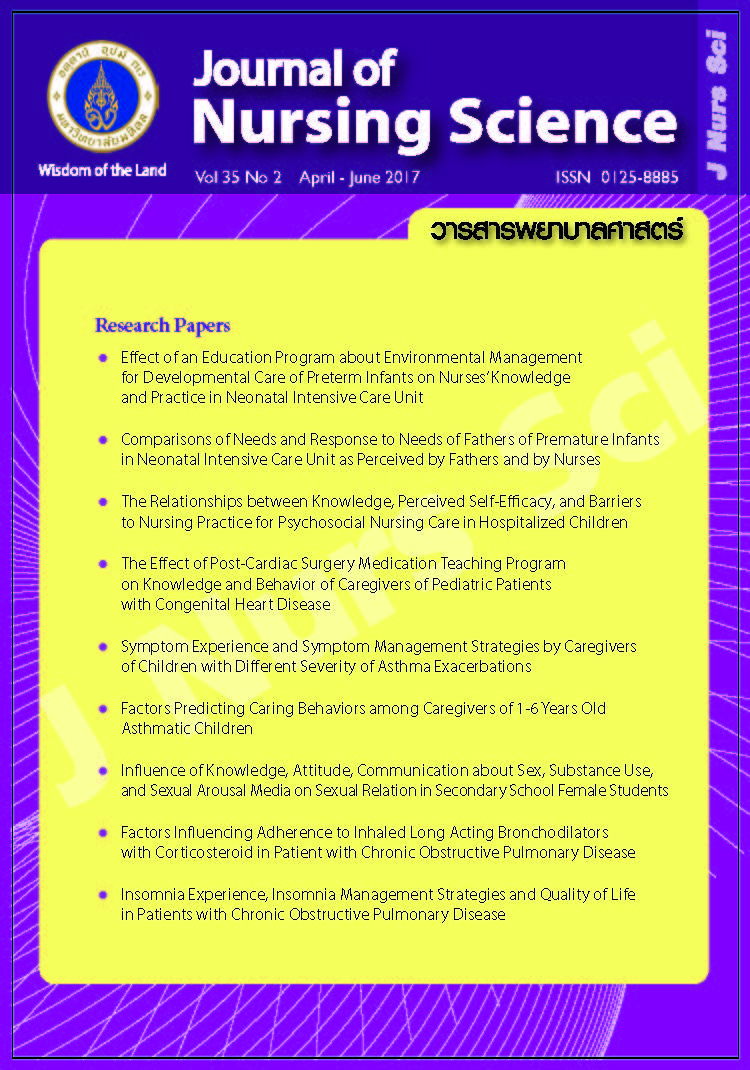Symptom Experience and Symptom Management Strategies by Caregivers of Children with Different Severity of Asthma Exacerbations
Main Article Content
Abstract
Abstract
Purpose: This study aimed to compare symptom experience and symptom management strategies among caregivers of children with different severity of asthma exacerbations.
Design: A descriptive comparative study.
Methods: The subjects comprised of 74 pairs of caregivers and children who visited hospitals with asthma exacerbations. The subjects were categorized by severity of asthma exacerbations based on Siriraj Clinical Asthma Score into three groups. Data were collected using the following questionnaires: demographic data; the perception of asthma symptoms; the caregiver-evaluated
severity of asthma exacerbations; and symptom management strategies. Data were analyzed by ANOVA and Bonferroni.
Main findings: Perception of asthma symptoms and caregiver-evaluated severity of asthma exacerbations were statistically significant difference in 3 groups (p < .05). The caregivers of children with mild exacerbations perceived asthma symptoms statistically significant difference from the caregivers of children with severe exacerbations (p < .05). The caregivers of children with mild exacerbations had statistically significant difference evaluated severity of asthma exacerbations from the caregivers of children with moderate to severe exacerbations (p < .05). The symptom management strategies employed by caregivers in three groups were not statistically significant difference (p > .05).
Conclusion and recommendations: Nurses should organize a program for caregivers of children with asthma to recognize and assess symptoms of exacerbations, be able to evaluate severity of asthma exacerbations, and to manage asthma symptoms to reduce severity of asthma exacerbations.
ประสบการณ์การพบอาการหอบของเด็กและกลวิธีในการจัดการอาการของผู้ดูแลเด็กโรคหืดที่มีความรุนแรงของอาการหอบแตกต่างกัน
บทคัดย่อ
วัตถุประสงค์: เพื่อเปรียบเทียบประสบการณ์การพบอาการหอบของเด็ก และกลวิธีในการจัดการอาการในกลุ่มผู้ดูแลเด็กโรคหืดที่มีความรุนแรงของอาการหอบแตกต่างกัน
รูปแบบการวิจัย: การศึกษาเชิงพรรณนาเปรียบเทียบ
วิธีดำเนินการวิจัย: กลุ่มตัวอย่าง คือ ผู้ดูแลและเด็กโรคหืดที่มารับบริการที่โรงพยาบาลด้วยอาการหอบ จำนวน 74 คู่ แบ่งกลุ่มตัวอย่างออกเป็น 3 กลุ่มตามระดับความรุนแรงแรงของอาการหอบด้วยเครื่องมือ Siriraj Clinical Asthma Score เก็บข้อมูลด้วยแบบสอบถามข้อมูลทั่วไป แบบสอบถามการรับรู้อาการหอบ แบบสอบถามการประเมินความรุนแรงของอาการหอบโดยผู้ดูแล และแบบสอบถามกลวิธีในการจัดการอาการหอบ วิเคราะห์ข้อมูลโดยใช้สถิติวิเคราะห์ความแปรปรวนทางเดียว (ANOVA) และสถิติ Bonferroni
ผลการวิจัย: การรับรู้อาการหอบและการประเมินความรุนแรงของอาการหอบโดยผู้ดูแลทั้ง 3 กลุ่มแตกต่างกันอย่างมีนัยสำคัญทางสถิติ (p < .05) ผู้ดูแลในกลุ่มเด็กที่มีความรุนแรงของอาการหอบระดับน้อย รับรู้อาการหอบแตกต่างจากผู้ดูแลในกลุ่มเด็กที่มีความรุนแรงของอาการหอบระดับมากอย่างมีนัยสำคัญทางสถิติ (p < .05) และผู้ดูแลในกลุ่มเด็กที่มีความรุนแรงของอาการหอบระดับน้อย ประเมินความรุนแรงของอาการหอบแตกต่างกับผู้ดูแลในกลุ่มเด็กที่มีความรุนแรงของอาการหอบระดับปานกลาง และระดับมากอย่างมีนัยสำคัญทางสถิติ (p < .05) ส่วนกลวิธีในการจัดการกับอาการหอบของผู้ดูแลทั้ง 3 กลุ่มไม่แตกต่างกัน (p > .05)
สรุป และข้อเสนอแนะ: พยาบาลควรจัดโปรแกรมส่งเสริมให้ผู้ดูแลทราบถึงอาการแสดงของอาการหอบ สามารถประเมินความรุนแรงของอาการหอบ และจัดการอาการหอบเพื่อลดระดับความรุนแรงของอาการหอบของเด็ก
คำสำคัญ: ประสบการณ์การพบอาการ กลวิธีในการจัดการอาการหอบ ผู้ดูแลเด็ก โรคหืด
Article Details
Copyright Notice: Nursing Science Journal of Thailand has exclusive rights to publish and distribute the manuscript and all contents therein. Without the journal’s permission, the dissemination of the manuscript in another journal or online, and the reproduction of the manuscript for non-educational purpose are prohibited.

Disclaimer: The opinion expressed and figures provided in this journal, NSJT, are the sole responsibility of the authors. The editorial board bears no responsibility in this regard.

